- Digital Marketing
- Updated 08/19/2025
How to Sell on Amazon for Beginners
You are finally ready to tackle that 800-pound gorilla. So, you think you are ready to sell on Amazon.
You’ve heard horror stories about high fees, lost shipments, lousy customer service, and worst of all, Amazon cannibalizes sales from your website. So, you ask yourself, how could anyone ever afford to sell on Amazon?
Let me calm your mind. Amazon can prove a challenge but very rewarding if you learn how to use the tools at your disposal the right way. It’s not hard to get started, and it’s even easier to make money profitably by selling on Amazon.
In this article, we walk you through setting up your account and discuss some essential components like Advertising and Account health.
What is Amazon?
Amazon is the world’s largest Direct-to-Consumer (DTC) eCommerce marketplace. As of December 2020, Amazon represented 47% of all US eCommerce sales. Amazon has a vast catalog of products across most categories and acts as a middleman between brands and Amazon’s customers.
If you are a DTC brand trying to grow your business online, Amazon should be an essential piece of your digital strategy.
Let’s talk about setting up your account.
Documents Required Before Opening Your Amazon Account
Be sure to have the following documents before you sign-up
- Business Information
- Legal business name, business address, email address, and point-of-contact information
- Government ID
- Tax ID
- Business Bill
- The bill must be in your business’s name, including the address
- Bank Account
Step-by-Step Process How to Sign Up on Amazon Seller Central
1. Go to https://services.amazon.com
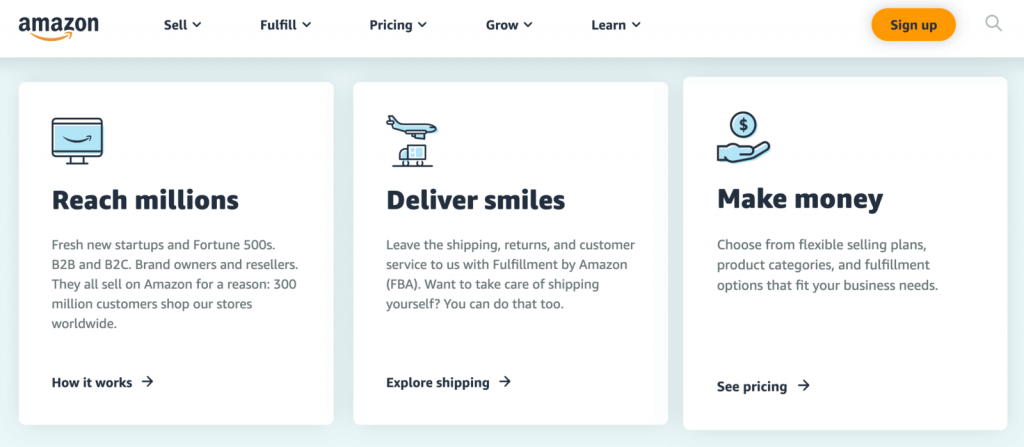
When you click the ‘Sign up’ button, you’ll be directed to the registration page for a professional seller.
2. Create a New Account
Once you click sign up, Create an account. Fill out all the appropriate information, including your email address. Click on ‘Create your Amazon account.
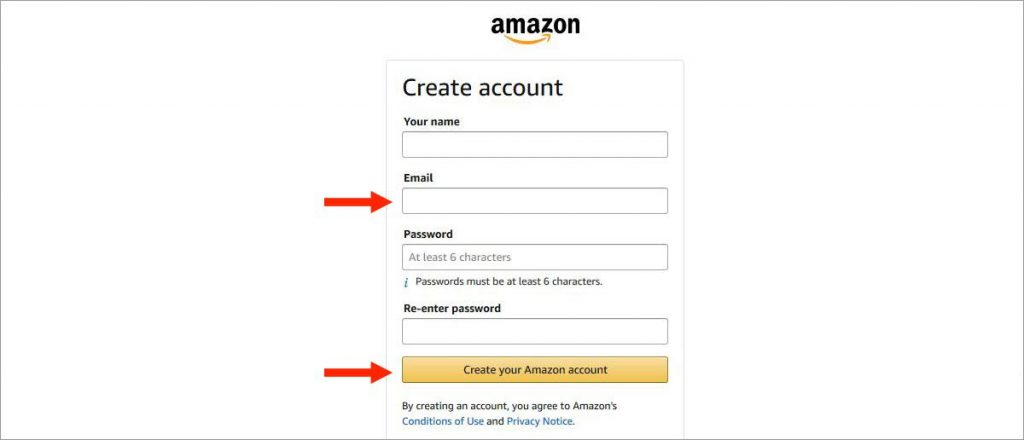
Amazon will email you an OTP verification code before you can proceed to the next step.
3. Business and Contact Address
Once on the registration page, enter your Business Location, Business Type, and POC.

4. Individual Information
In this section, enter the account owner’s information. It is essential as the owner of the account will have access to certain features that other admin will not access.
Once you’ve filled in all of the information, click the ‘Next’ button.
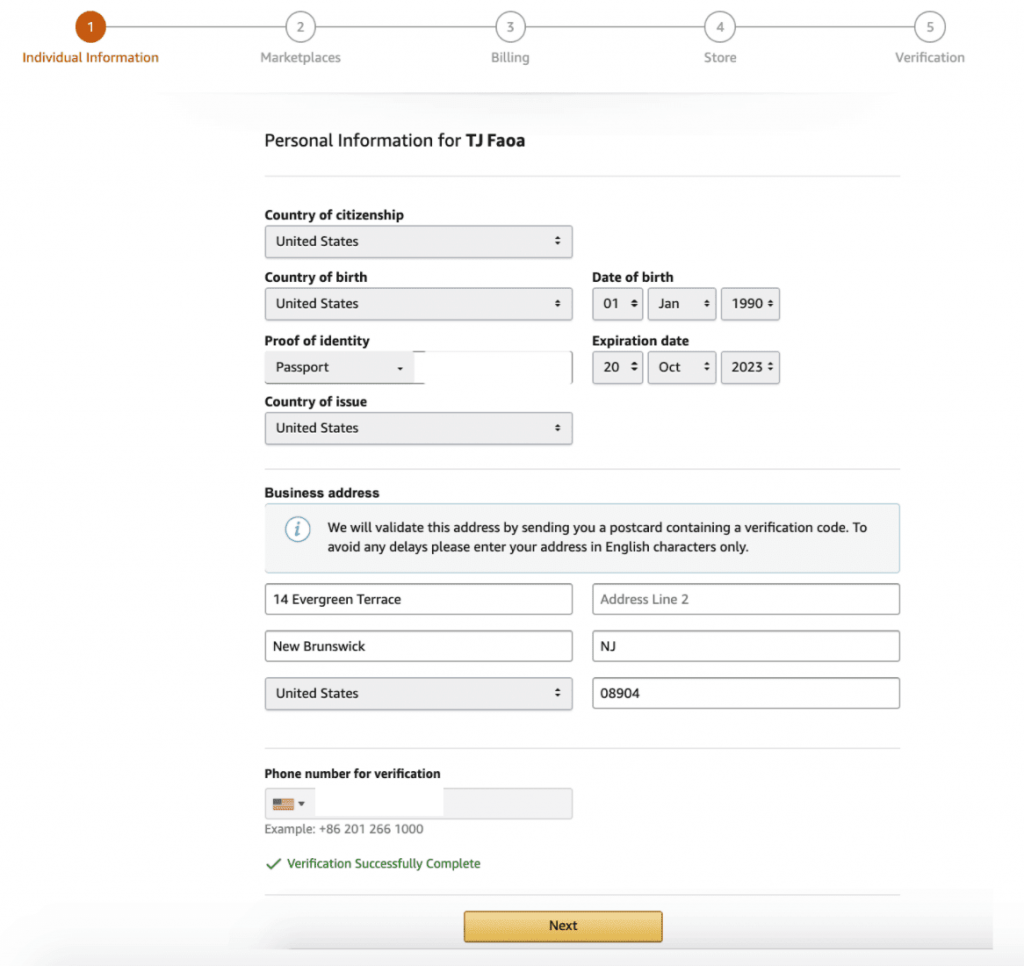
5. Choose Your Marketplace(s)
Here you will select your marketplace where you want to sell (e.g., Amazon.ca, Amazon.co.uk, etc.)
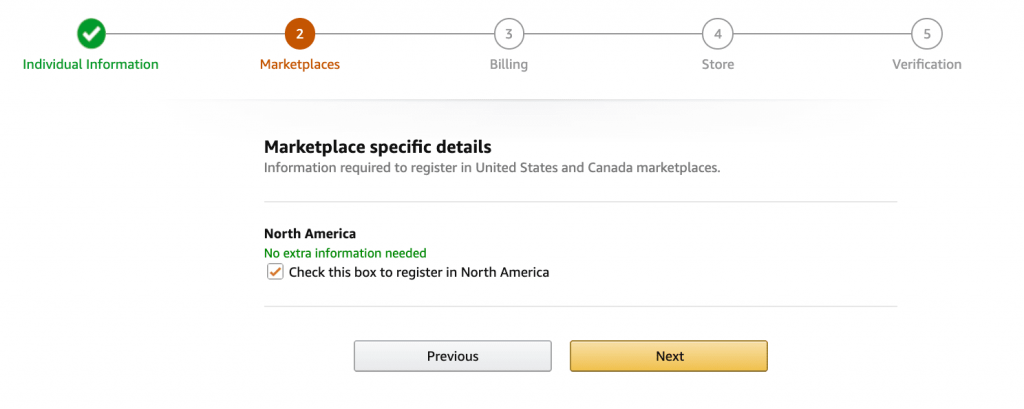
6. Enter Your Billing Information
After choosing your marketplace(s), you have to enter your business’s credit card information.
Here is more information about the selling plans available on Amazon.
Click ‘Next’ at the bottom of the page.
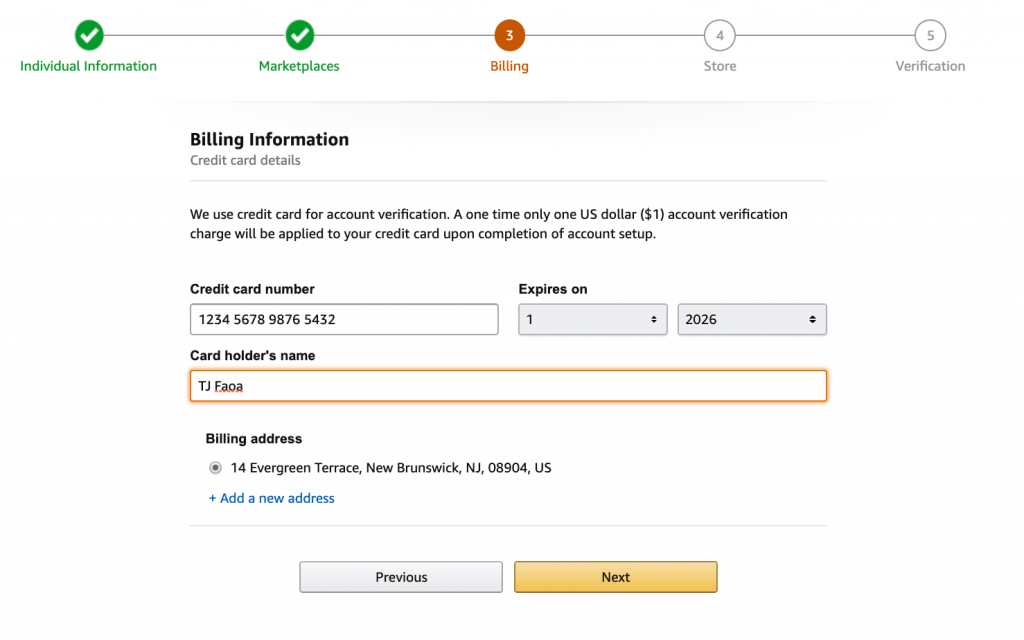
7. Amazon Store
In this section, you will give Amazon some high-level information about your Store.
- Name of Amazon Shop
- If you have a TradeMark or plan on getting a Trade Mark to be sure the name matches the Trade Mark verbatim
- Universal Product Code (UPC)
- Select if you are the manufacturer or brand owner of the product
- Note if you have a trademark on your brand

Click “Next” after providing the required information.
8. Address Validation
When you have completed all the steps mentioned earlier, you will be asked to confirm your business address.
After confirming your address, you will receive a postcard at your given address with a verification code inside.
Enter the code and click on ‘next’ to finish the verification process.
Once you’re verified, you’re good to go.
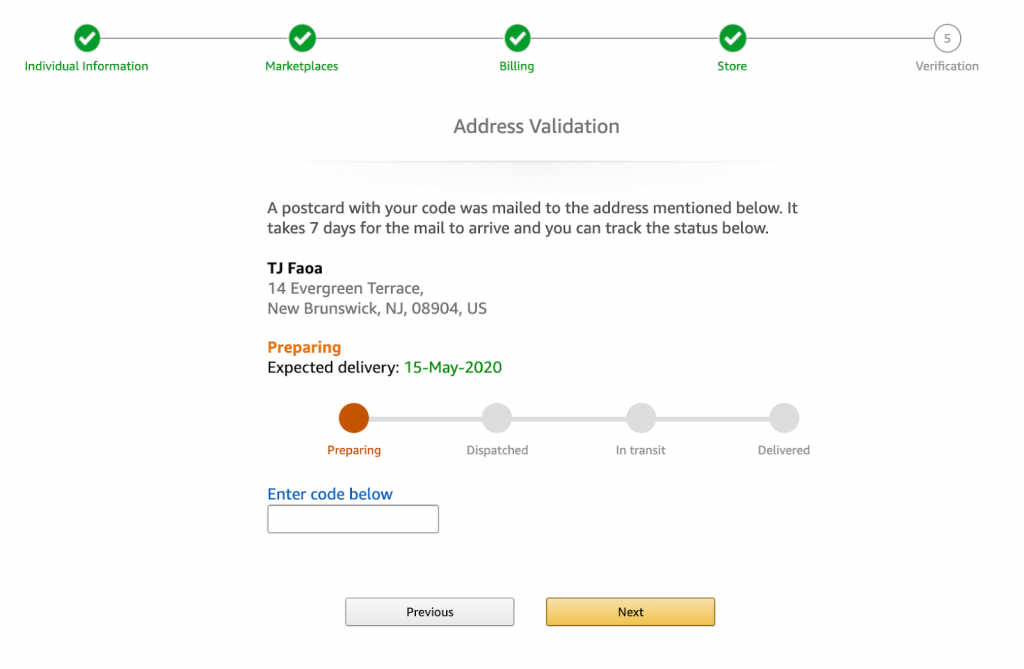
Choose Your Fulfillment Method
After opening a store on Amazon, the next step is to choose your fulfillment method. Amazon offers Seller Central sellers as means of fulfilling orders. Either yourself or using a 3PL provider or through Amazon fulfillment centers through their Fulfillment by Amazon (FBA) program.
- Fulfillment by Amazon (FBA) – Amazon ships the products you sell. Amazon Sellers using an FBA model will ship products to a fulfillment center. Your products will be Prime eligible for Amazon shoppers. Amazon charges FBA fees for this service.
- Fulfillment by Merchant (FBM) – as the merchant, you will properly pick, pack and ship your orders on time following all Amazon’s terms and conditions.
Amazon Brand Registry
To be eligible for Brand Registry features, you must own a Principle Trademark on your brand. Amazon offers the Intellectual Property (IP) Accelerator program who want their Trademark in a few weeks. Brand Registry helps the seller against any hijacker, brand privileges, control over the listings, and additional features like:
- A+ Content Creation
- Sponsored Brands Ads
- Storefront
- Brand Analytics Tools
Listing of Product
The seller has to create a listing to sell on Amazon. You must have to buy Universal Product Code (UPC) for your new listings, or Amazon can issue you an FNSKU.
A basic listing consist of the following elements:
- Title
- Product Images
- Bullet Points
- Description
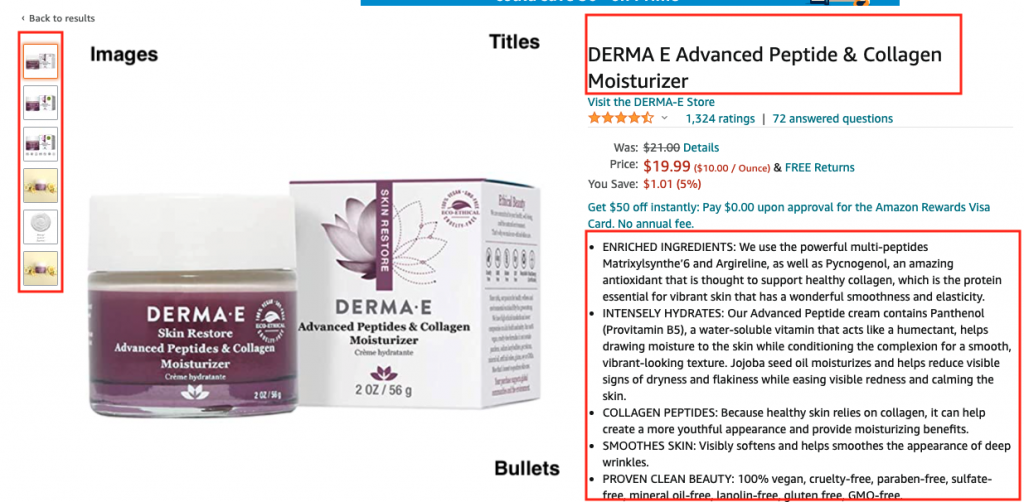

A major component of creating your listing is ensuring that it is appropriately categorized and being indexed for the correct keywords. Amazon uses each word in your listing to properly index them in the category. Ensure that your Amazon listing is optimized for search to improve your chances of being found.
Advertising on Amazon
One of the solutions Amazon Advertising Console offers its sellers is pay-per-click (PPC) advertising which gives advertisers the ability to bid and win search page placement on keywords customers search in Amazon. Properly leveraging Amazon PPC is the best way to generate awareness, traffic, and sales to your products.
There are three advertising solutions under PPC:
- Sponsored Products
- Sponsored Brands
- Sponsored Display
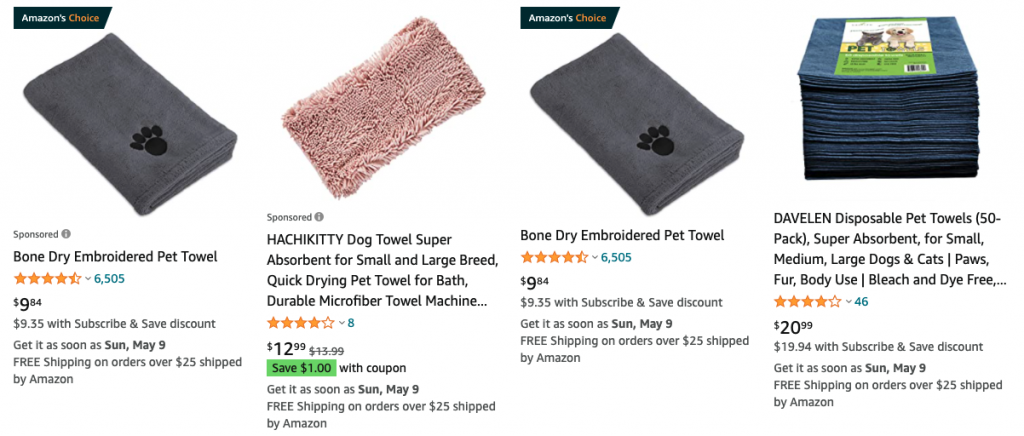
Sponsored Products
Sponsored Product ads appear on search engine results pages (SERPs) and product detail pages. This ad type allows advertisers to leverage keywords and productions using Amazon’s Standard Identification Numbers (ASINs) to target potential shoppers.
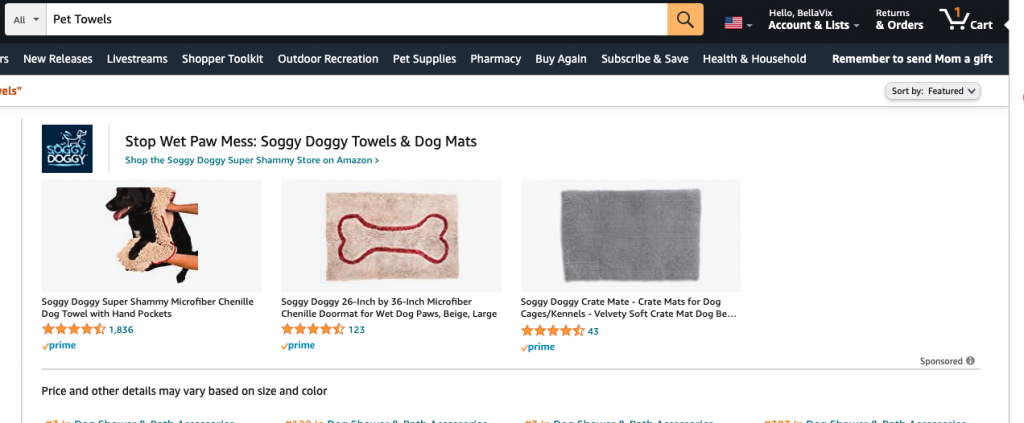
Sponsor Brands
Sponsored Brand ads are for Brand Registered sellers only. These ads are served based on keywords or products. This ad type is the most visually appealing and allows the advertiser to showcase a small image, 50 characters of copy, and showcase three products.

Sponsored Display
Sponsored Display ads appear on and off of Amazon. These ads are served based on audience type. This ad type allows advertisers to leverage in-market, lifestyle and remarketing audiences to target potential shoppers.
Account Management on Amazon
To build and maintain a successful Amazon business, it is crucial that you are spending time checking essential aspects of your account. There are many considerations in maintaining a healthy Amazon account.
Account Health
Amazon uses an Account Health Rating feature to help you monitor your Amazon’s account performance in Seller Central. The account health feature is only available to Professional Sellers.
Amazon uses your account standings as a way to ensure policies are followed to the level agreed upon in your Seller’s Terms of Service.
Final Thoughts
There are many aspects to consider when determining if Amazon is the right channel for your business. Amazon has a built-in customer base that trusts Amazon and Amazon brands due to years of excellent customer service and innovation. Amazon has become the largest eCommerce marketplace in the United States. We see that more and more customers are starting their product discovery journey on Amazon because of that level of trust.
If you aren’t on Amazon, then you are falling short on your obligations to your customers. Because right now, at this very moment. Your customers are shopping on Amazon, and if they aren’t finding your products, then whose products are they finding?
About the Author:
Will Haire
Will runs a Full-Service Amazon Agency, BellaVix. He has worked with eCommerce businesses in the planning and tactical execution of marketing strategies on all Amazon business segments.